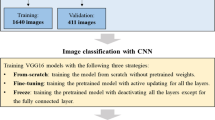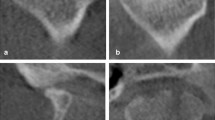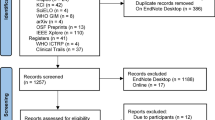Abstract
This study proposes a new diagnostic tool for automatically extracting discriminative features and detecting temporomandibular joint disc displacement (TMJDD) accurately with artificial intelligence. We analyzed the structural magnetic resonance imaging (MRI) images of 52 patients with TMJDD and 32 healthy controls. The data were split into training and test sets, and only the training sets were used for model construction. U-net was trained with 100 sagittal MRI images of the TMJ to detect the joint cavity between the temporal bone and the mandibular condyle, which was used as the region of interest, and classify the images into binary categories using four convolutional neural networks: InceptionResNetV2, InceptionV3, DenseNet169, and VGG16. The best models were InceptionV3 and DenseNet169; the results of InceptionV3 for recall, precision, accuracy, and F1 score were 1, 0.81, 0.85, and 0.9, respectively, and the corresponding results of DenseNet169 were 0.92, 0.86, 0.85, and 0.89, respectively. Automated detection of TMJDD from sagittal MRI images is a promising technique that involves using deep learning neural networks. It can be used to support clinicians in diagnosing patients as having TMJDD.




Similar content being viewed by others
References
Cai, X. Y., J. M. Jin, and C. Yang. Changes in disc position, disc length, and condylar height in the temporomandibular joint with anterior disc displacement: a longitudinal retrospective magnetic resonance imaging study. J. Oral Maxillofac. Surg. 69:e340-346, 2011.
De Rossi, S. S., M. S. Greenberg, F. Liu, and A. Steinkeler. Temporomandibular disorders: evaluation and management. Med. Clin. N. Am. 98:1353–1384, 2014.
Deng, J., W. Dong, R. Socher, L. Li, L. Kai, and F.-F. Li. ImageNet: a large-scale hierarchical image database. IEEE Conf. Comput. Vis. Pattern Recogn. 2009:248–255, 2009.
Ferreira, L. A., E. Grossmann, E. Januzzi, M. V. de Paula, and A. C. Carvalho. Diagnosis of temporomandibular joint disorders: indication of imaging exams. Braz. J. Otorhinolaryngol. 82:341–352, 2016.
Frazier, J. J., and C. J. Spencer. CBCT imaging of degenerative joint disease of the temporomandibular joints. Gen. Dent. 67:17–19, 2019.
Gauer, R. L., and M. J. Semidey. Diagnosis and treatment of temporomandibular disorders. Am. Fam. Phys. 91:378–386, 2015.
Huang, G., Z. Liu, L. V. D. Maaten, and K. Q. Weinberger. Densely connected convolutional networks. IEEE Conf. Comput. Vis. Pattern Recogn. (CVPR). 2017:2261–2269, 2017.
Kim, S. H., Z. W. Geem, and G. T. Han. Hyperparameter optimization method based on harmony search algorithm to improve performance of 1D CNN human respiration pattern recognition system. Sensors (Basel, Switzerland). 20:3697, 2020.
Kowalchuk, R. M., R. O. Kowalchuk, K. Kaplan-List, J. M. Caplash, and P. Block. Temporomandibular Joint Internal Derangement Score (TIDS): novel magnetic resonance imaging assessment score and its relation to invasive treatment in patients with clinical temporomandibular joint pathology. Heliyon.4:e00916, 2018.
Larheim, T. A., A. K. Abrahamsson, M. Kristensen, and L. Z. Arvidsson. Temporomandibular joint diagnostics using CBCT. Dentomaxillofac Radiol. 44:20140235, 2015.
Lee, K. S., H. J. Kwak, J. M. Oh, N. Jha, Y. J. Kim, W. Kim, U. B. Baik, and J. J. Ryu. Automated detection of TMJ osteoarthritis based on artificial intelligence. J. Dent. Res. 99:1363–1367, 2020.
Lopes, S. L., A. L. Costa, A. D. Cruz, L. M. Li, and S. M. de Almeida. Clinical and MRI investigation of temporomandibular joint in major depressed patients. Dento Maxillo Fac. Radiol. 41:316–322, 2012.
Matsubara, R., Y. Yanagi, K. Oki, M. Hisatomi, K. C. Santos, B. O. Bamgbose, M. Fujita, S. Okada, S. Minagi, and J. Asaumi. Assessment of MRI findings and clinical symptoms in patients with temporomandibular joint disorders. Dento Maxillo Fac. Radiol. 47:20170412, 2018.
Nascimento Falcão, I., M. B. C. Cal Alonso, L. H. da Silva, S. Lopes, L. P. Comar, and A. L. F. Costa. 3D morphology analysis of TMJ articular eminence in magnetic resonance imaging. Int. J. Dent. 2017:5130241, 2017.
Ottria, L., V. Candotto, F. Guzzo, M. Gargari, and A. Barlattani. Temporomandibular joint and related structures: anatomical and Histological aspects. J. Biol. Regul. Homeost. Agents. 32:203–207, 2018.
Racich, M. J. Occlusion, temporomandibular disorders, and orofacial pain: an evidence-based overview and update with recommendations. J. Prosthet. Dent. 120:678–685, 2018.
Scrivani, S. J., D. A. Keith, and L. B. Kaban. Temporomandibular disorders. N. Engl. J. Med. 359:2693–2705, 2008.
Senior, A., G. Heigold, M. Ranzato, K. Yang. An empirical study of learning rates in deep neural networks for speech recognition. 2013 IEEE international conference on acoustics, speech and signal processing, 6724–6728, 2013.
Simonyan, K., A. Zisserman. Very deep convolutional networks for large-scale image recognition. https://arxiv.org/abs/1409.1556, 2014.
Sudre, C. H., W. Li, T. Vercauteren, S. Ourselin, and M. Jorge Cardoso. Generalised Dice Overlap as a Deep Learning Loss Function for Highly Unbalanced Segmentations. Cham: Springer, pp. 240–248, 2017.
Summa, S., R. Ursini, P. F. Manicone, F. Molinari, and R. Deli. MRI assessment of temporomandibular disorders: an approach to diagnostic and therapeutic setting. Cranio. 32:131–138, 2014.
Szegedy, C., S. Ioffe, V. Vanhoucke, A. Alemi. Inception-v4, inception-ResNet and the impact of residual connections on learning. AAAI conference on artificial intelligence, 2016.
Szegedy, C., V. Vanhoucke, S. Ioffe, J. Shlens, Z. B. Wojna. Rethinking the Inception Architecture for Computer Vision, 2016.
Szegedy, C., L. Wei, J. Yangqing, P. Sermanet, S. Reed, D. Anguelov, D. Erhan, V. Vanhoucke, and A. Rabinovich. Going deeper with convolutions. IEEE Conf. Comput. Vis. Pattern Recogn. (CVPR). 2015:1–9, 2015.
Talaat, W. M., O. I. Adel, and S. Al Bayatti. Prevalence of temporomandibular disorders discovered incidentally during routine dental examination using the Research Diagnostic Criteria for Temporomandibular Disorders. Oral Surg. Oral Med. Oral Pathol. Oral Radiol. 125:250–259, 2018.
Talmaceanu, D., L. M. Lenghel, N. Bolog, M. Hedesiu, S. Buduru, H. Rotar, M. Baciut, and G. Baciut. Imaging modalities for temporomandibular joint disorders: an update. Clujul Med. (1957). 91(3):280–287, 2018.
Vogl, T. J., H.-C. Lauer, T. Lehnert, N. N. N. Naguib, P. Ottl, N. Filmann, H. Soekamto, and N.-E.A. Nour-Eldin. The value of MRI in patients with temporomandibular joint dysfunction: correlation of MRI and clinical findings. Eur. J. Radiol. 85(4):714–719, 2016.
Weiss, K., T. M. Khoshgoftaar, and D. Wang. A survey of transfer learning. J. Big Data. 3:9, 2016.
Yosinski, J., J. Clune, Y. Bengio, H. Lipson. How transferable are features in deep neural networks? Proceedings of the 27th international conference on neural information processing systems - Volume 2, 3320–3328, 2014.
Zhou, B., A. Khosla, A. Lapedriza, A. Oliva, and A. Torralba. Learning deep features for discriminative localization. IEEE Conf. Comput. Vis. Pattern Recogn. (CVPR). 2016:2921–2929, 2016.
Acknowledgments
The authors acknowledge the financial support for research purpose by the Clinical Innovation Center (CiC) of the Taipei Veterans General Hospital, Taipei, Taiwan (CIC008) and Pervasive Artificial Intelligence Research Labs (PAIR Labs) of National Yang Ming Chiao Tung University, Taipei, Taiwan (111W10159). The funders have no role in study design, data collection, analysis, and interpretation, or in writing of the manuscript.
Author Contributions
ZKK: Conceptualization, Data Curation, Formal analysis, Methodology, Software, Validation, Visualization, Writing—original draft. NTC: Conceptualization, Methodology, Software. HTHW: Investigation, Resources. DHW: Formal analysis, Writing—original draft. YYK: Resources. WCC: Software, Visualization. PCT: Visualization. WLL: Conceptualization, Funding acquisition, Project administration, Writing—review & editing. YTW: Validation, Supervision, Writing—review & editing.
Conflict of interest
All authors declare that they have no conflict of interest.
Author information
Authors and Affiliations
Corresponding authors
Additional information
Associate Editor Stefan M. Duma oversaw the review of this article.
Publisher's Note
Springer Nature remains neutral with regard to jurisdictional claims in published maps and institutional affiliations.
Rights and permissions
Springer Nature or its licensor holds exclusive rights to this article under a publishing agreement with the author(s) or other rightsholder(s); author self-archiving of the accepted manuscript version of this article is solely governed by the terms of such publishing agreement and applicable law.
About this article
Cite this article
Kao, ZK., Chiu, NT., Wu, HT.H. et al. Classifying Temporomandibular Disorder with Artificial Intelligent Architecture Using Magnetic Resonance Imaging. Ann Biomed Eng 51, 517–526 (2023). https://doi.org/10.1007/s10439-022-03056-2
Received:
Accepted:
Published:
Issue Date:
DOI: https://doi.org/10.1007/s10439-022-03056-2




